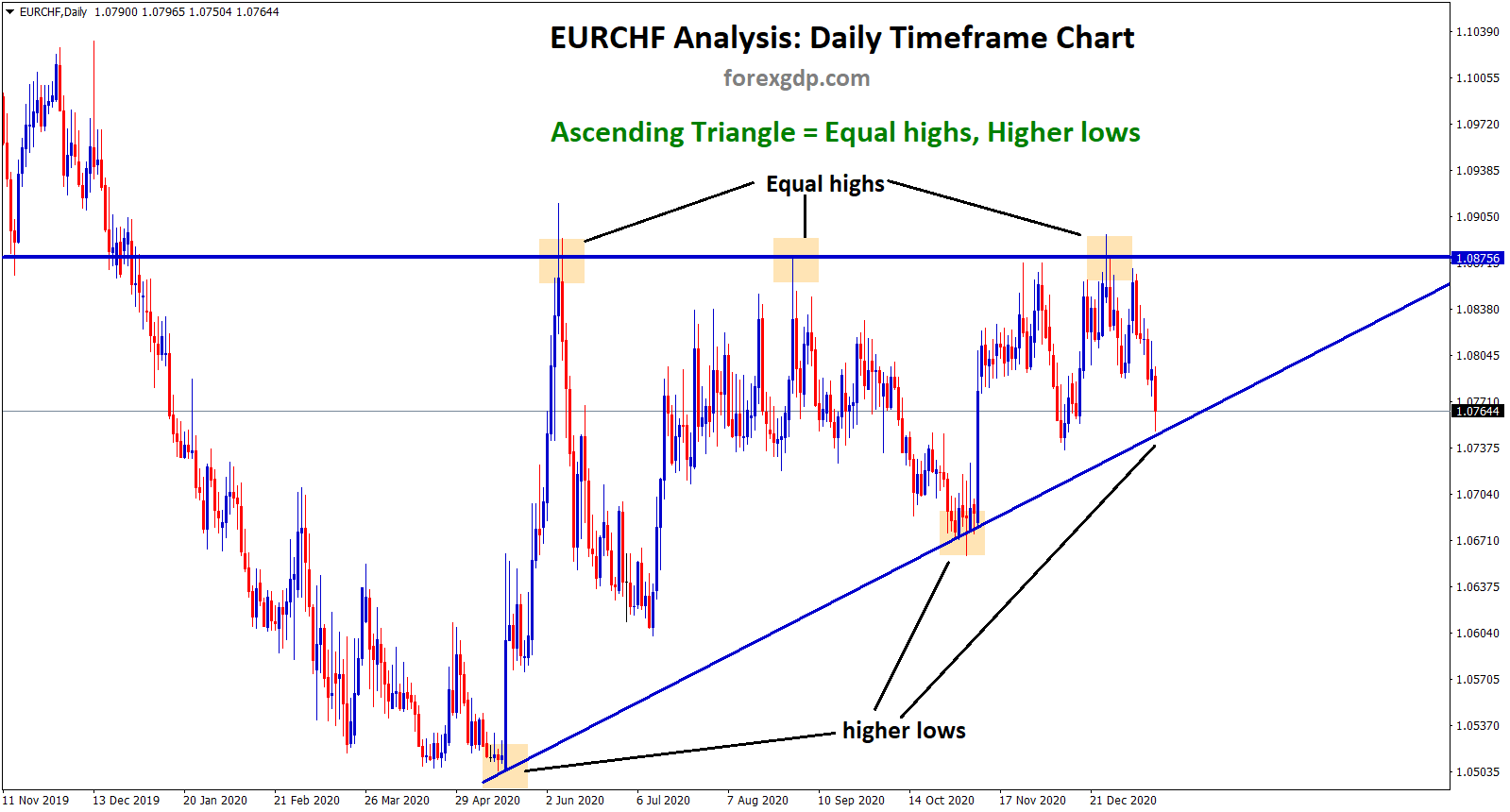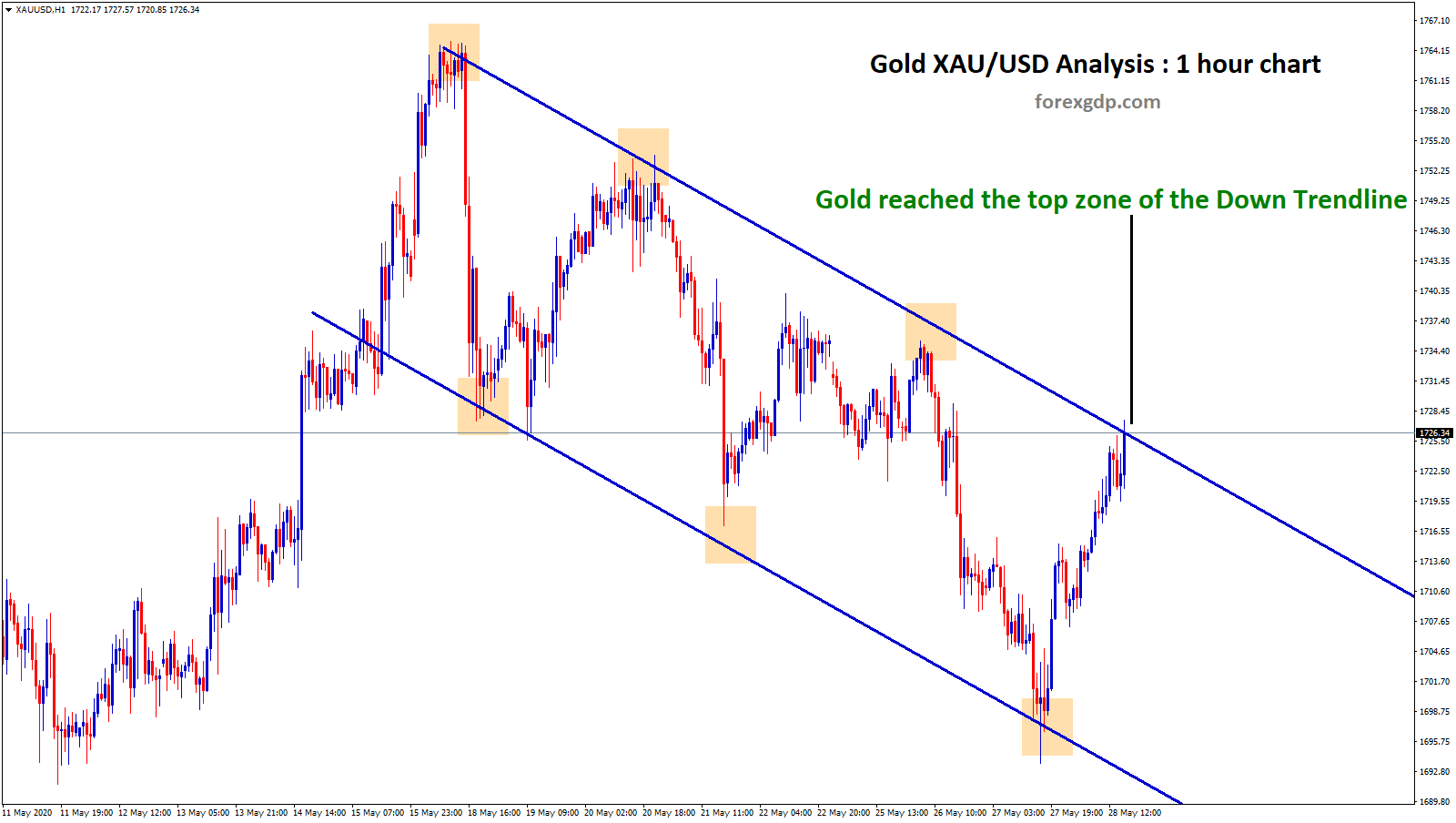XAUUSD has reached horizontal resistance area of the pattern
GOLD – Gold Surges Amid Lower US Inflation and Federal Reserve Speculations
Gold surged above $2,400 during the North American session on Friday, closing in on its all-time high of $2,431. The precious metal gained over 1.5% amid rising US Treasury bond yields, demonstrating its resilience as a non-yielding asset.
The catalyst for Gold’s ascent was the lower-than-expected inflation reading for April in the United States. The Consumer Price Index (CPI) indicated a decrease, which helped push Gold above the significant $2,400 level. At the same time, the US Dollar weakened, with the US Dollar Index (DXY) falling to 104.45, down by 0.03%. This drop in the Dollar spurred speculation that the Federal Reserve (Fed) might lower interest rates in 2024, although Fed officials have maintained a cautious outlook, stressing that a single favorable inflation report is insufficient to change their policy stance.
The Federal Reserve’s cautious stance is influenced by the need to monitor ongoing economic data closely. Despite recent inflationary easing, most Fed officials, including Atlanta Fed President Raphael Bostic and Cleveland Fed President Loretta Mester, have underscored the importance of patience in their approach to adjusting interest rates. They emphasized that more consistent data is needed to confirm a sustainable trend toward the Fed’s 2% inflation target.
Additionally, the market’s expectations for a December 2024 rate cut by the Fed were slightly adjusted, with the fed funds rate futures contract indicating a reduction from 36 basis points (bps) to 35 bps by year-end. This minor adjustment reflects ongoing uncertainty about the future direction of monetary policy.

Gold’s price advance occurred despite higher US Treasury yields, which typically weigh on non-yielding assets like Gold. The yield on the 10-year US Treasury note rose to 4.42%, an increase of four-and-a-half bps from its opening level. Concurrently, the DXY decreased to 104.40, down 0.04%, reflecting a weaker US Dollar.
The Bureau of Labor Statistics (BLS) reported that US inflation resumed its downward trajectory in April after stalling for six months. The core CPI, which excludes volatile food and energy prices, dropped from 3.8% to 3.6% year-over-year, easing some of the pressure on the Fed. Additionally, weaker-than-expected Retail Sales data has further bolstered expectations for potential rate cuts.
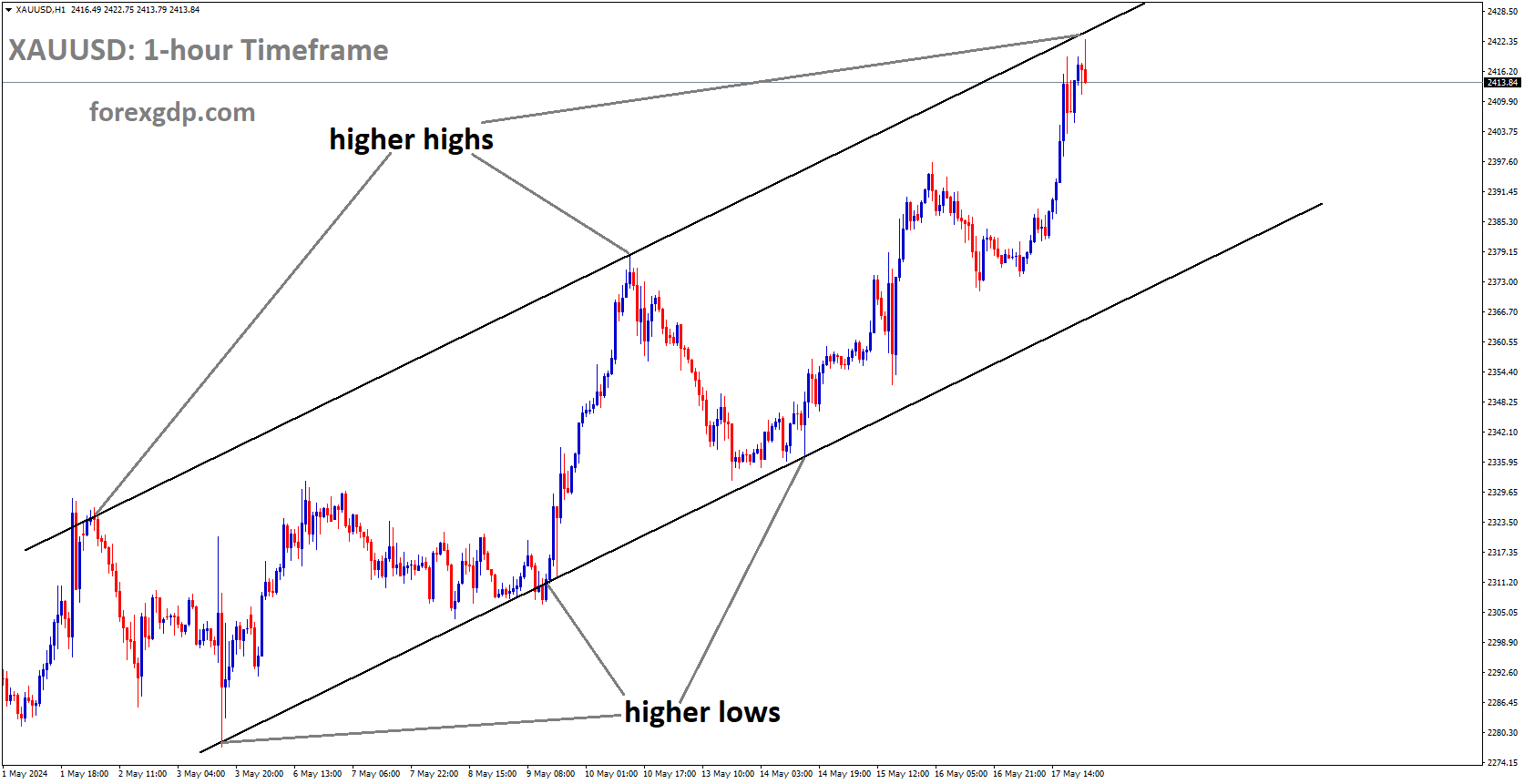
XAUUSD is moving in Ascending channel and market has reached higher high area of the channel
Following the release of the inflation data, US equities rallied to new all-time highs, while the Greenback and US Treasury yields experienced sharp declines. Richmond Fed President Thomas Barkin acknowledged the recent decline in inflation but emphasized that it would take more time to achieve the Fed’s target. Cleveland Fed President Loretta Mester supported the latest CPI data, noting that the Fed’s current monetary policy stance remains appropriate as they continue to assess incoming economic data. Fed Governor Michelle Bowman remarked that while the current policy is restrictive, there is a readiness to raise rates if inflation stalls or reverses.
In summary, Gold’s climb above $2,400 was driven by lower US inflation, a weakening US Dollar, and ongoing market speculation about future Fed rate cuts. Despite the cautious stance of Fed officials and rising Treasury yields, Gold has demonstrated its strength, reflecting investor sentiment in the face of economic uncertainty.
EURUSD – Rebounds as US Dollar Weakens Amid Interest Rate Speculations
The EUR/USD pair experienced a notable recovery from its intraday low during Friday’s American session, spurred by a weakening US Dollar. Despite the Federal Reserve’s (Fed) persistent advocacy for maintaining a restrictive monetary policy, market sentiment has shifted towards anticipating potential interest rate cuts in the near future.
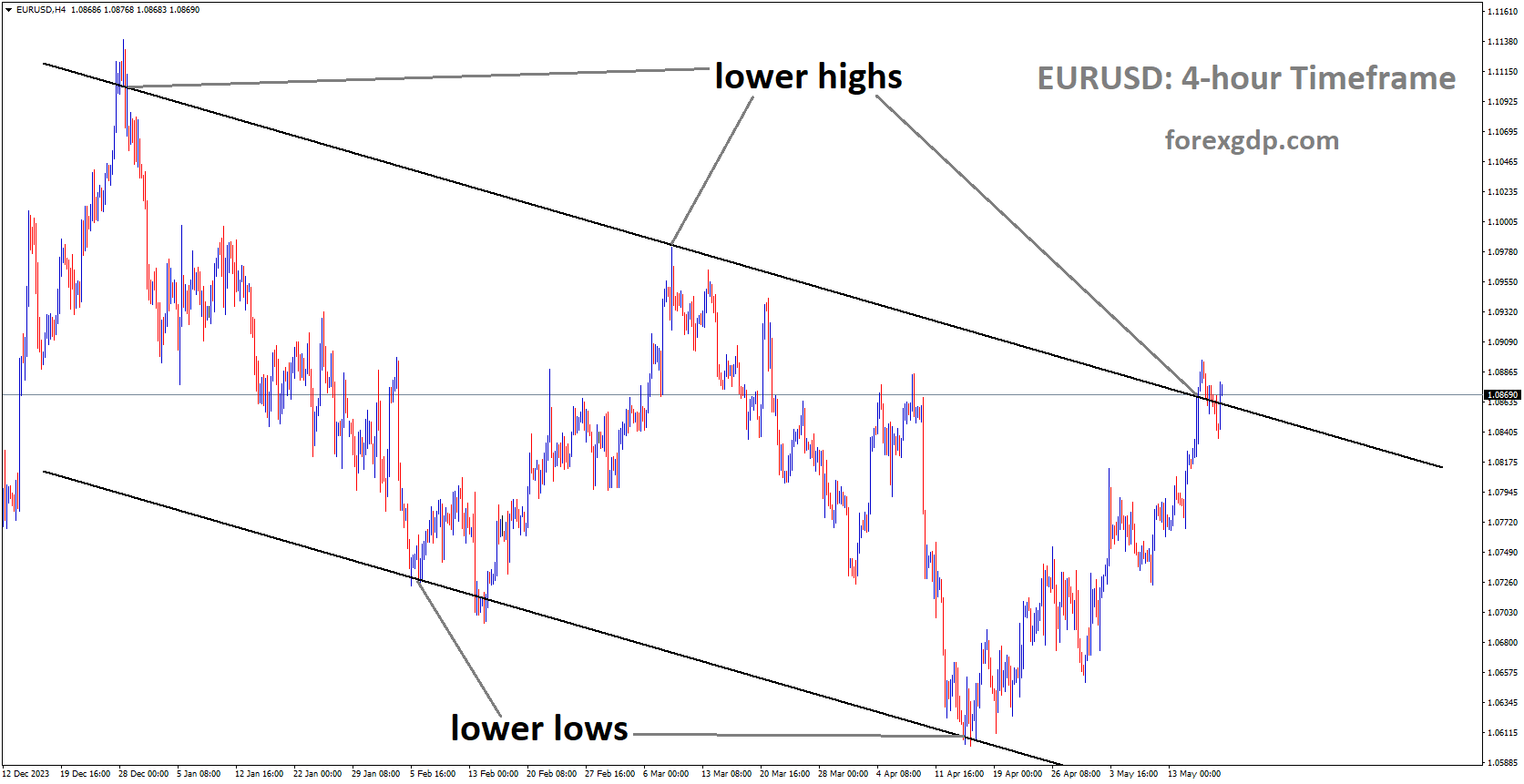
EURUSD is moving in Descending channel and market has reached lower high area of the channel
Earlier in the week, the US Dollar saw a temporary boost following the release of the Consumer Price Index (CPI) report for April, which indicated a decline in US inflation. However, this boost was short-lived as speculation grew that the Fed might begin reducing interest rates as early as the September meeting. This speculation has undermined the Dollar’s strength.
On the other side of the Atlantic, the Euro found support from comments made by European Central Bank (ECB) policymakers. ECB Board member Isabel Schnabel highlighted the uncertainty surrounding the path beyond the anticipated June rate cut. She stressed that recent inflation data suggest the final stages of disinflation are particularly challenging and warned of the risks posed by premature rate cuts.
The US Dollar Index (DXY), which tracks the Greenback’s value against six major currencies, pulled back from its intraday high, failing to maintain its recovery momentum. This retreat occurred despite multiple Fed officials, including New York Fed President John Williams, reiterating the need to keep interest rates at their current levels. Williams emphasized that the monetary policy remains appropriately restrictive and stated that there are no immediate economic indicators necessitating a policy change.

Adding to the uncertainty, the US labor market’s strength is being questioned. The US Department of Labor reported an increase in initial jobless claims for the week ending May 10, rising to 222,000 from the previous week’s 232,000. Although this is a slight decrease, it still reflects potential weaknesses in the job market, with higher jobless claims indicating fewer job opportunities or increased layoffs. Additionally, April’s Nonfarm Payroll (NFP) growth was significantly below expectations, further fueling concerns about the US economy’s health.
In summary, while the Fed maintains a hawkish stance on interest rates, growing market speculation about potential rate cuts and emerging concerns over the US labor market have led to a weakening US Dollar. This environment has allowed the Euro to recover, with ECB officials remaining cautious about the risks associated with premature interest rate reductions.
USDJPY – Yen Weakens as BoJ and Fed Policies Diverge
Japanese Yen (JPY) softened as Bank of Japan (BoJ) President Kazuo Ueda addressed the parliament, providing updates on monetary policy and recent market events. The Yen has been unable to sustain gains against the US Dollar (USD), resulting in a flat trading performance for the week and consecutive losses. This decline nearly reversed the significant gains made mid-week following the release of the US Consumer Price Index (CPI) report, which indicated easing inflation pressures in the United States.
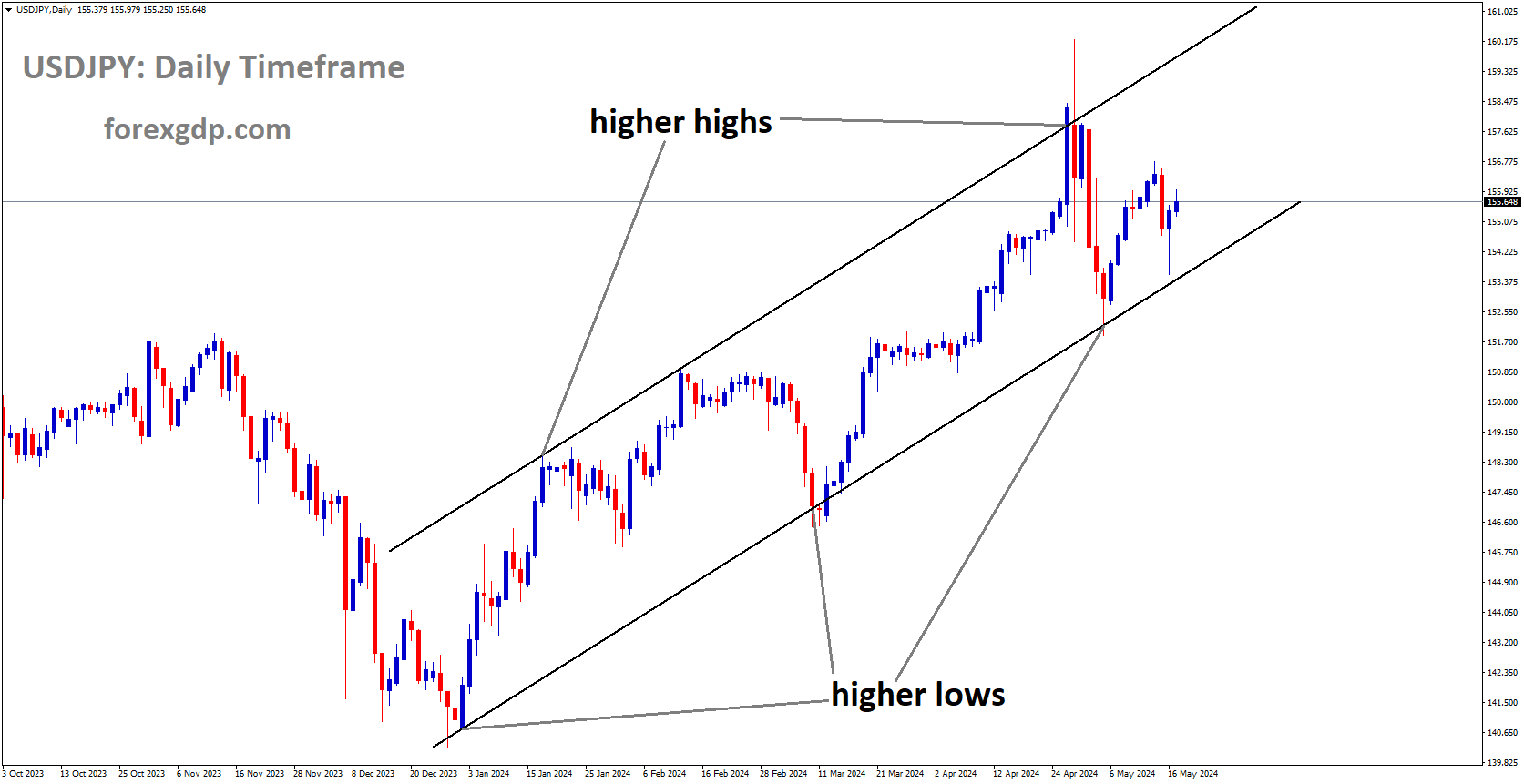
USDJPY is moving in Ascending channel and market has reached higher low area of the channel
During Ueda’s parliamentary session, his comments did not provide any substantial market-moving insights, leading to a tepid response from investors. Meanwhile, the US Dollar Index (DXY), which measures the value of the US Dollar against a basket of six major currencies, extended its recovery after a sharp decline earlier in the week. The interest rate differential continues to lend some support to the Dollar; however, recent economic data no longer shows robust outperformance, and US inflation seems to be returning to its disinflationary trend.
The economic calendar did not feature any major US data releases, allowing market participants to digest the recent developments. Several US Federal Reserve (Fed) officials were scheduled to speak, potentially influencing market sentiment:
Neel Kashkari, President of the Federal Reserve Bank of Minneapolis, was set to deliver opening remarks at the International Organization for Standardization Technical Committee 68 (ISO/TC 68) financial services plenary meeting.

Following Kashkari, Federal Reserve Governor Christopher Waller was expected to speak on payment innovation at the same event.
Mary Daly, President of the Federal Reserve Bank of San Francisco, was scheduled to give a speech at the University of San Francisco School of Management commencement ceremony. Both Daly and Waller are voting members of the Federal Open Market Committee (FOMC) this year.
In the equity markets, the performance was mixed. Japan’s Topix index closed with a modest gain, while the Nikkei ended slightly lower. US equity futures were still seeking direction ahead of the opening bell. According to the CME FedWatch Tool, there is a 91.3% probability that the Federal Reserve will maintain current interest rates in the June meeting. However, the tool also indicates a 50.5% chance of a 25 basis point rate cut by September.
In summary, the Japanese Yen’s recent struggle reflects investor uncertainty amid mixed economic signals and cautious central bank communications. As market participants digest the latest data and await further insights from central bank officials, the currency markets remain volatile.
USDCAD – Canadian Dollar Steady Ahead of CPI Data and Fed Outlook
Canadian Dollar (CAD) remained steady on Friday, experiencing low volatility as traders prepared for the upcoming long weekend. This calm followed a hectic week where markets adjusted their expectations for Federal Reserve (Fed) rate cuts after the US Consumer Price Index (CPI) inflation showed signs of easing, reaching a three-month low in April.
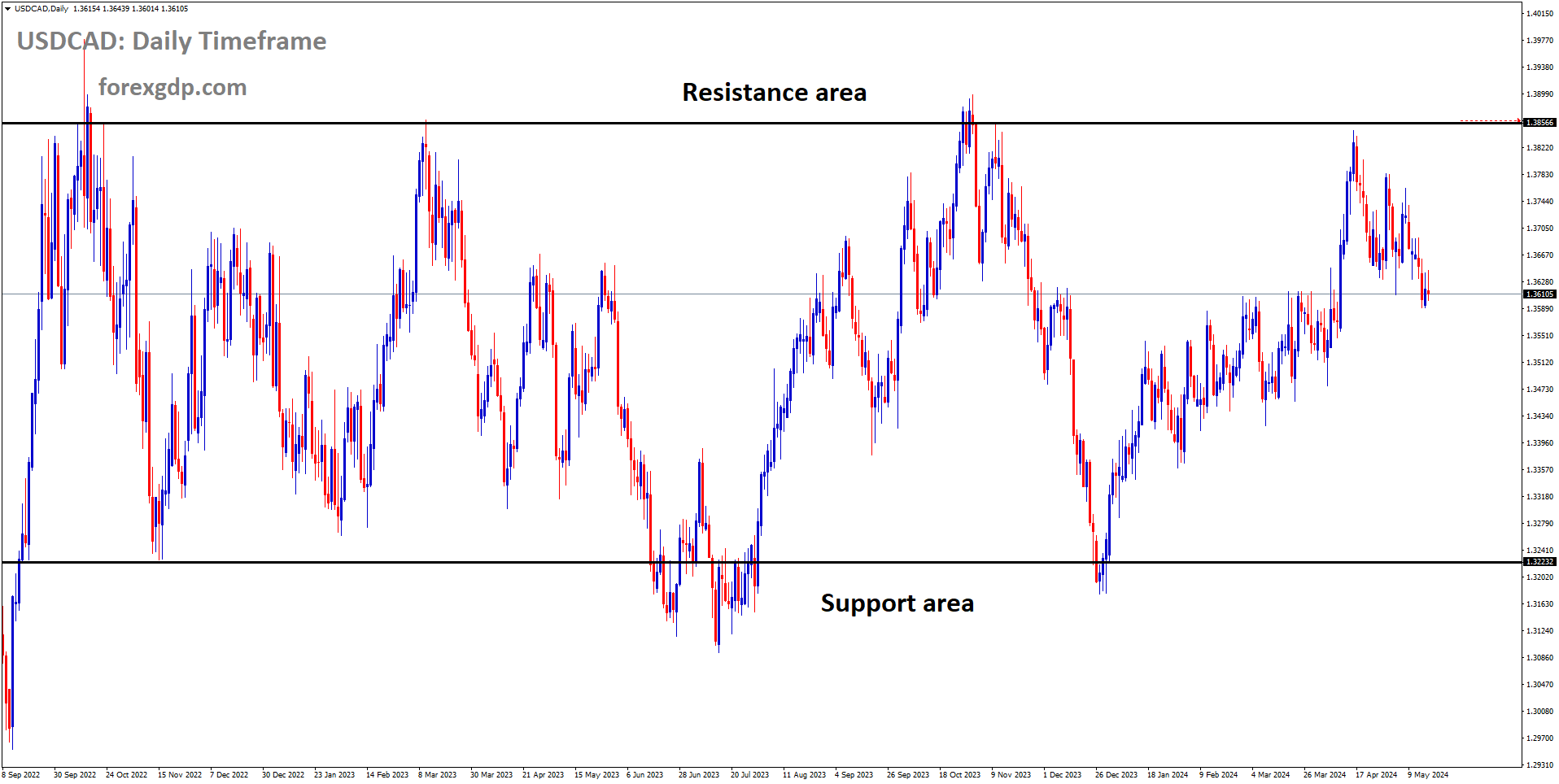
USDCAD is moving in box pattern and market has fallen from the resistance area of the pattern
With Canadian markets set to close on Monday in observance of Victoria Day, traders are gearing up for Tuesday when the latest CPI inflation data will be released. This data will be closely watched to gauge the health of the Canadian economy and its potential impact on the CAD.
Investors are also focusing on the Fed’s next moves. The recent easing of US inflation has led to increased speculation about potential rate cuts. The CME’s FedWatch Tool now indicates nearly a 70% chance of at least a quarter-point rate cut by September. This shift in sentiment is driven by the belief that the Fed may take action to support economic growth as inflation trends toward the 2% target.
In March, Foreign Portfolio Investment in Canada saw a significant rise to $14.37 billion, far exceeding the forecast of $3.51 billion and reversing a revised decline of $-4.28 billion from the previous month. This strong investment inflow highlights positive investor sentiment towards Canada and provides a supportive backdrop for the CAD.
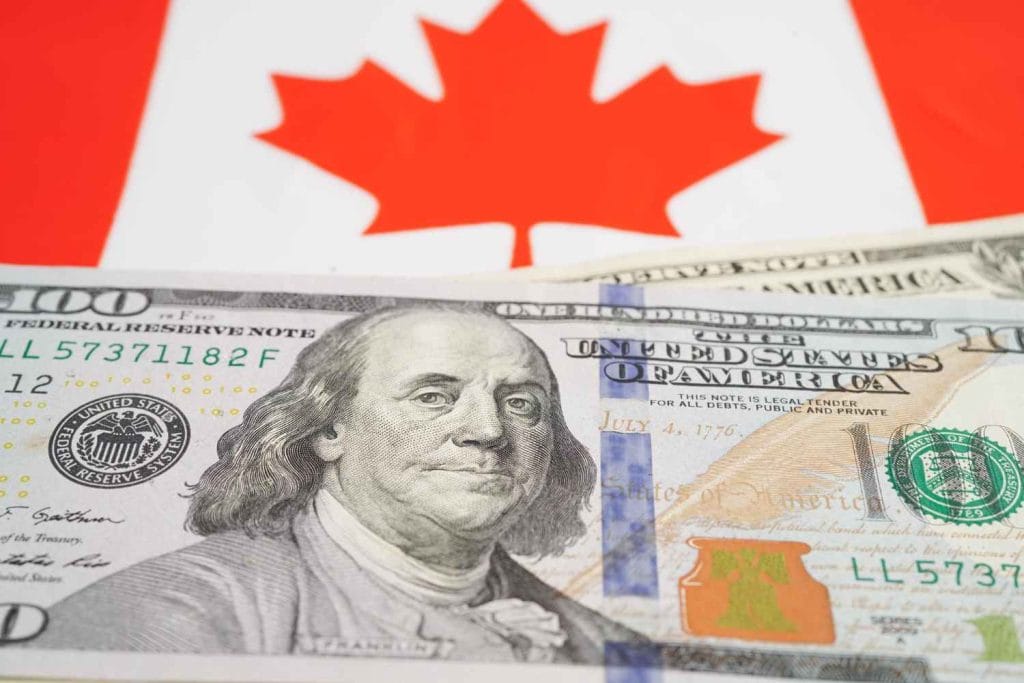
Next week, several key events are expected to further influence market sentiment. Fed officials will speak at the Financial Markets Conference hosted by the Federal Reserve Bank of Atlanta. These appearances are highly anticipated as they may offer insights into the Fed’s policy direction. Additionally, the Federal Open Market Committee (FOMC) will release its latest meeting minutes, which investors will scrutinize for any indications of dovish language or potential rate cuts.
Overall, the Canadian Dollar is navigating a landscape of mixed economic signals. While the recent data has been supportive, the upcoming CPI release and Fed communications will be critical in determining the CAD’s trajectory in the near term.
USDCHF – USD/CHF Rises on Weak Swiss Data and Strong US Dollar
USD/CHF pair continued to climb on Friday, driven by weaker-than-expected Swiss industrial production data and a resilient US Dollar (USD). During the early European trading session, the pair showed significant momentum due to these economic influences.
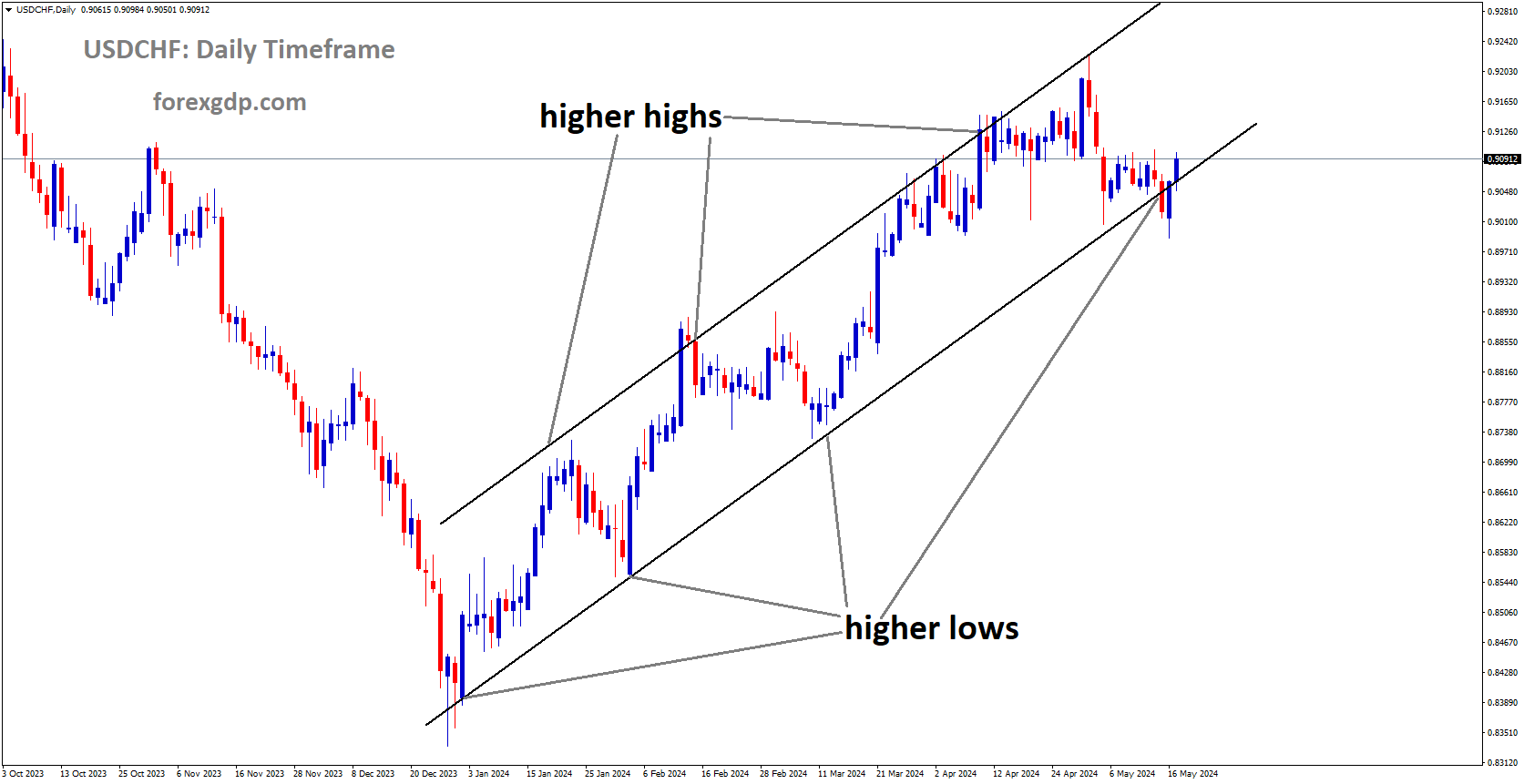
USDCHF is moving in Ascending channel and market has reached higher low area of the channel
Swiss industrial production experienced a notable decline of 3.1% in the first quarter, marking the second consecutive quarter of reduced industrial activity. This followed an upwardly revised 0.5% decline in the previous quarter. On a seasonally adjusted basis, industrial output fell by 1%, compared to a revised 1.1% drop in the prior quarter. The ongoing weakness in Swiss industrial production has put downward pressure on the Swiss Franc (CHF), contributing to the USD/CHF pair’s strength.
On the US front, the Federal Reserve (Fed) continues to adopt a cautious stance on inflation and interest rates, which has supported the USD. Key Fed officials have reiterated the need for a patient approach. On Thursday, Atlanta Fed President Raphael Bostic emphasized the necessity of patience with interest rates, highlighting persistent pricing pressures within the US economy. Cleveland Fed President Loretta Mester also suggested that it may take longer than anticipated to accurately assess the inflation trajectory, advocating for a prolonged restrictive monetary policy stance.
Further adding to the USD’s support, the US Department of Labor reported higher-than-expected initial jobless claims on Thursday. The number of Americans filing new claims for jobless benefits rose to 222,000 for the week ending May 10, slightly above market expectations of 220,000 but below the previous week’s figure of 232,000. This labor market data has increased market speculation that the Fed might consider a rate cut in September.

Overall, the combination of weak Swiss industrial production data and a strong US Dollar, underpinned by the Fed’s cautious approach to inflation and interest rates, has driven the USD/CHF pair higher. As markets digest these economic signals and anticipate further developments from central banks, the pair’s trajectory will likely remain influenced by upcoming data releases and policy communications.
USD Index – US Dollar Gains Strength from Robust Q2 Growth and Fed Strategy
Federal Reserve officials and solid Q2 economic growth are providing support to the US Dollar, limiting potential downside risks. Market participants are speculating that the easing cycle might start in September, but robust economic indicators have so far influenced the Fed’s cautious approach, preventing any immediate rate cuts.
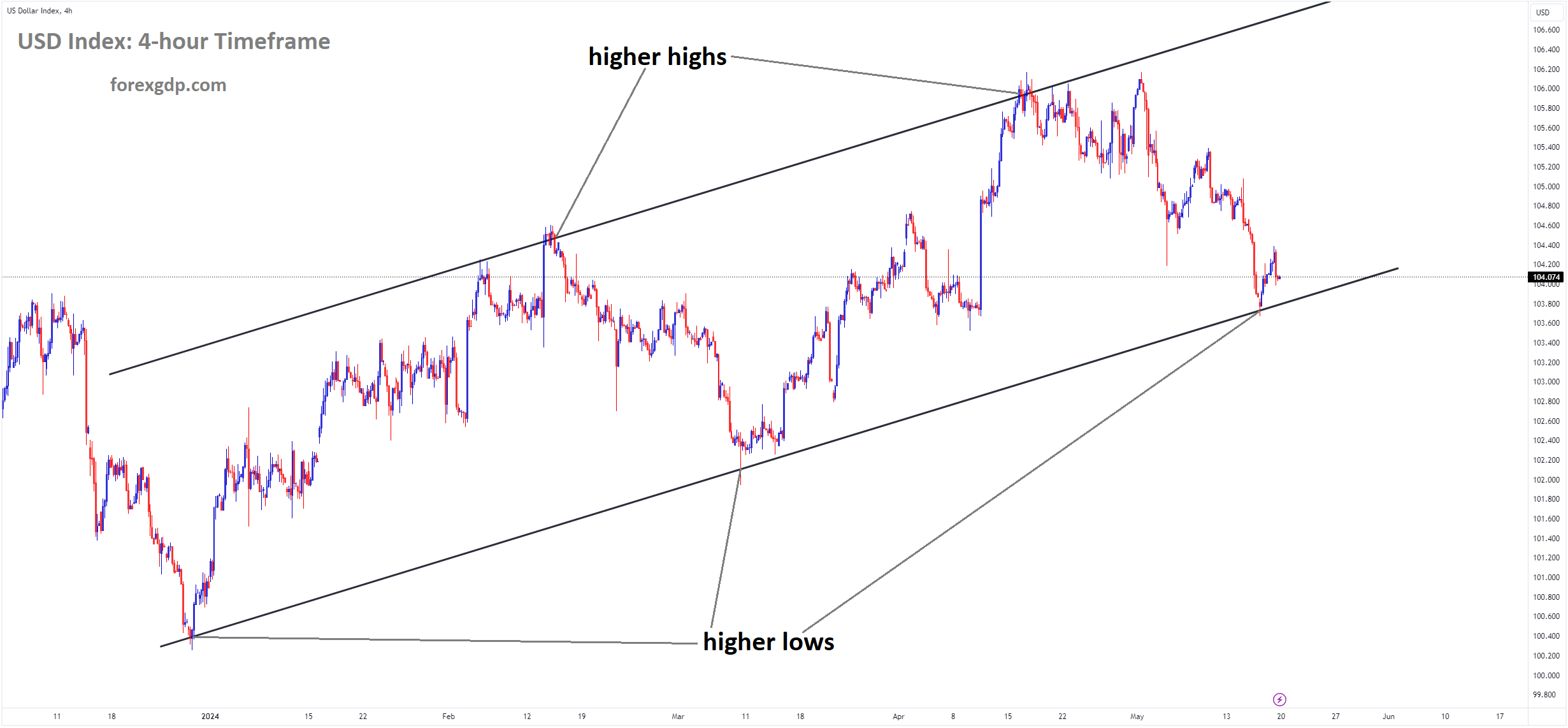
USD Index Market price is moving in Ascending channel and market has reached higher low area of the channel
The US Dollar Index (DXY) remains steady at 104.50, reflecting a neutral stance. The positive performance of the US economy in the second quarter, combined with the Fed’s reluctance to lower rates, has contributed to mild gains for the Dollar towards the end of the week.
Despite signs of softness in certain economic indicators, such as April’s Consumer Price Index (CPI) and Retail Sales figures, the overall growth in Q2 has been resilient. An increase in weekly Initial Jobless Claims earlier in the week led to some weakening of the US Dollar, but the broader economic strength has kept the Greenback afloat.
Several key Fed officials have shared their views on the current economic landscape:
Raphael Bostic, President of the Atlanta Fed, highlighted positive inflation trends in April but stressed that the Fed is not yet ready to reduce the policy rate, citing ongoing pricing pressures.
Loretta Mester, President of the Cleveland Fed, indicated that the current monetary policy stance is appropriate as the Fed continues to assess incoming data.
Thomas Barkin, President of the Richmond Fed, pointed out that current inflation rates still need to meet target levels, suggesting a continued need for a restrictive policy stance.

The CME FedWatch Tool shows that markets are increasingly expecting the first rate cut to happen in September, but there remains a possibility of an earlier cut in July if economic data continues to underperform.
The mixed economic data has created a complex scenario for the Fed. While the labor market shows some signs of strain, overall economic growth remains robust. This has led to a cautious approach from the Fed, supporting the US Dollar by preventing any immediate rate reductions.
In summary, the US Dollar is benefiting from the Fed’s cautious stance and solid Q2 growth. Market expectations are leaning towards a potential rate cut in September, though continued economic underperformance could prompt an earlier move. The evolving economic landscape will be crucial in determining the Fed’s future actions and the subsequent impact on the US Dollar.
GBPUSD – UK Inflation Focus Pressures Sterling as Fed Holds Firm
The Pound Sterling (GBP) experienced a pullback during Friday’s American session, following a fresh monthly high achieved on Thursday. Investors are now closely watching the upcoming release of the United Kingdom Consumer Price Index (CPI) data for April, which is scheduled for Wednesday. This data is anticipated to provide critical insights into the Bank of England’s (BoE) future interest rate decisions.
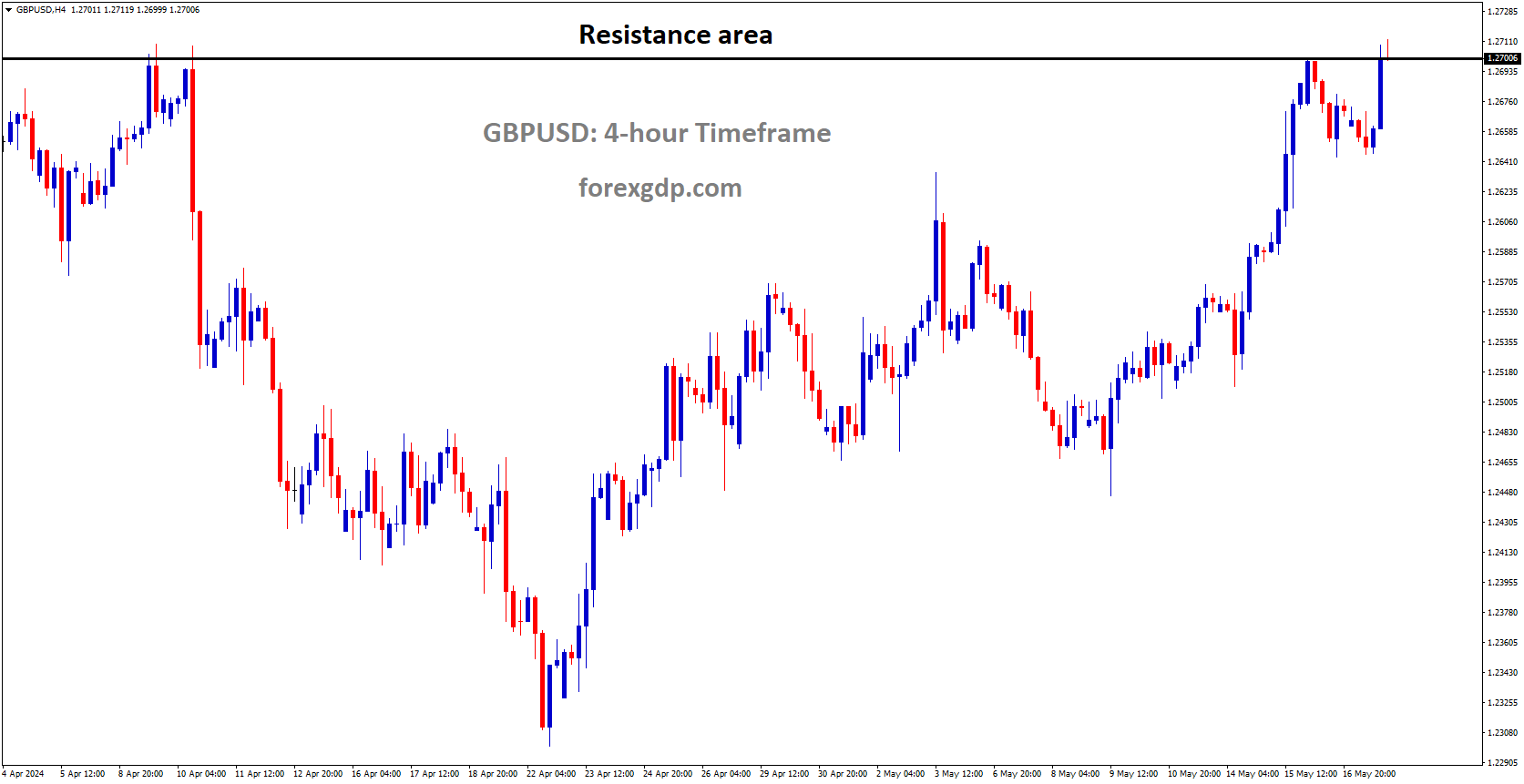
GBPUSD has reached horizontal resistance area of the pattern
The UK inflation figures are expected to be a significant determinant in the BoE’s next steps. Currently, market participants are divided on whether the BoE will commence interest rate reductions in June or August. BoE Governor Andrew Bailey has previously suggested that UK inflation could approach the 2% target shortly, consistent with the bank’s earlier forecasts. He mentioned that following the March CPI data release on April 17, there was an expectation of a considerable drop in inflation due to the unique energy pricing system in the UK.
Despite the recent upward movement in the Pound Sterling, it encountered resistance as market sentiment turned cautious. On the other side of the Atlantic, the US Dollar gained strength driven by the Federal Reserve’s (Fed) hawkish stance on interest rates. Fed officials have reiterated that the current interest rate framework remains appropriate, even with an anticipated decline in US inflation data for April. They stressed that a single month’s reduction in inflation is insufficient to confirm the continuation of the disinflation process that had stalled in the first quarter of the year.
Hawkish remarks from Fed policymakers have dampened speculation about imminent rate cuts. Investors now believe that the earliest the Fed might reduce rates would be at the September meeting. The CME FedWatch tool reflects this sentiment, showing a decrease in the probability of a rate cut in September from 73% to 68% following the latest inflation data. The Fed’s commitment to maintaining higher interest rates for an extended period has provided some support to the US Dollar. The US Dollar Index (DXY), which measures the Greenback’s value against a basket of six major currencies, rebounded after reaching a new monthly low but is still expected to close the week on a negative note.

In the United States, concerns about the labor market’s strength intensified. The Department of Labor reported higher-than-expected Initial Jobless Claims for the week ending May 10, with 222,000 new claims, surpassing the estimate of 220,000 but lower than the previous week’s eight-month high of 232,000. This data highlights ongoing challenges in the labor market, adding to the complex economic landscape the Fed must navigate in its policy decisions.
AUDUSD – Australian Dollar Falls Amid Mixed China Data and Lower Bond Yields
Australian Dollar (AUD) extended its decline for the second consecutive session on Friday, impacted by mixed economic data from China. This data, crucial due to the close trade relationship between Australia and China, saw China’s retail sales rise for the 15th consecutive month but at the slowest rate in this sequence, increasing by only 2.3% year-over-year in April, compared to March’s 3.1% and below the expected 3.8%. Industrial production, however, grew by 6.7% year-over-year, surpassing expectations.
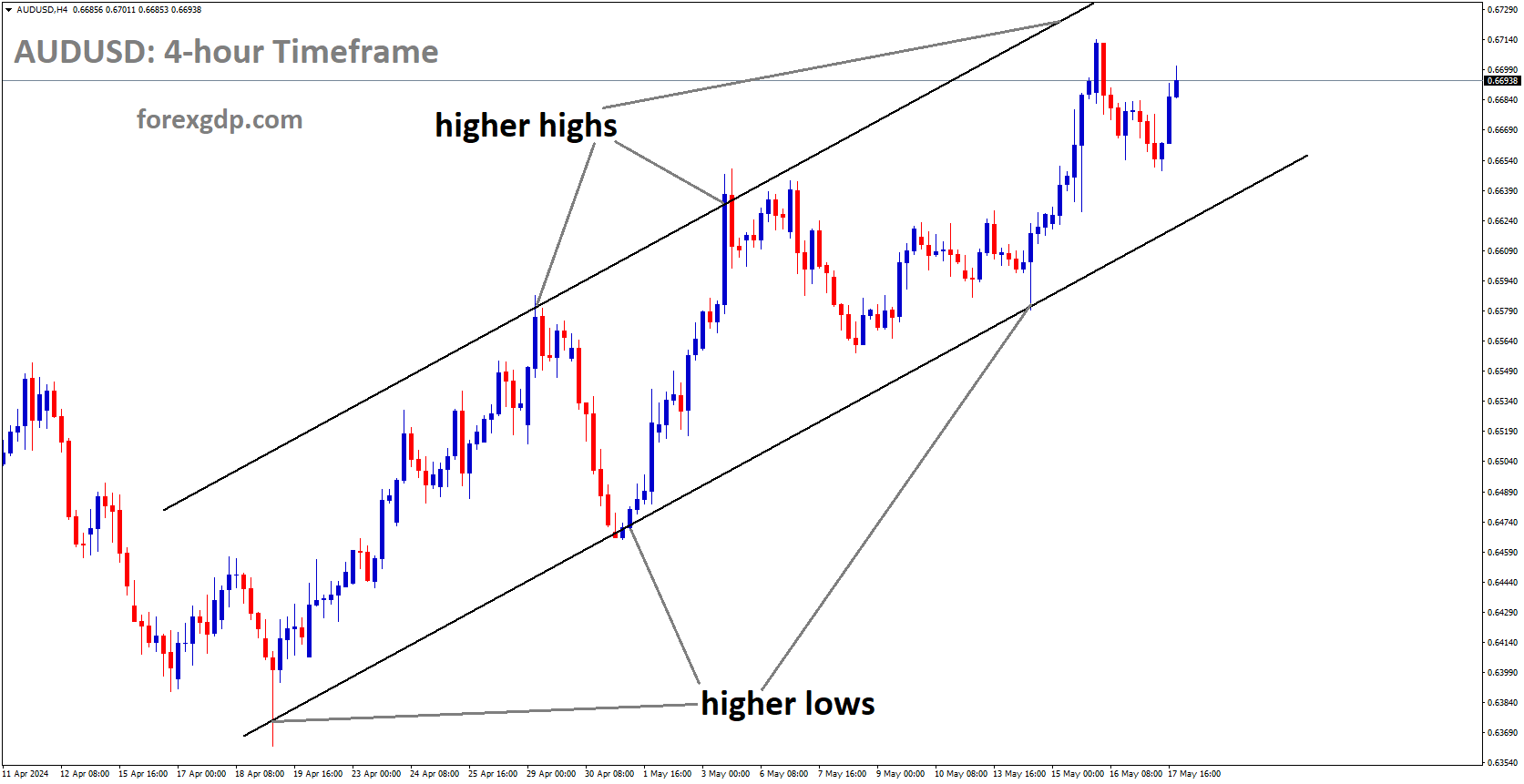
AUDUSD is moving in Ascending channel
The AUD’s struggles were compounded by a drop in Australia’s 10-year government bond yield to a monthly low of 4.2%. This decline followed Australia’s employment figures, which presented a mixed picture with unexpected slowing in wage growth during the first quarter. The Wage Price Index increased by 0.8% quarter-over-quarter, below the market forecast of 0.9%. Annual pay growth also slowed to 4.1% from the previous 4.2%. These factors have led markets to discount the possibility of interest rate hikes by the Reserve Bank of Australia (RBA).
In contrast, the US Dollar (USD) showed strength, with the US Dollar Index (DXY) rebounding from a multi-week low. The Federal Reserve (Fed) maintained a cautious stance on inflation and potential rate cuts in 2024. Fed officials, including Neel Kashkari and Mary Daly, were scheduled to speak later in the day, likely providing further insights into the Fed’s outlook.
The US labor market data released on Thursday showed that initial jobless claims rose to 222,000 for the week ending May 10, slightly above the market consensus but below the previous week’s figure of 232,000. Meanwhile, Federal Reserve officials emphasized patience with interest rates. Raphael Bostic, President of the Federal Reserve Bank of Atlanta, and Loretta Mester, President of the Cleveland Fed, both highlighted the need for a prolonged restrictive stance to manage inflation effectively.

Additionally, Australia’s latest budget for 2024-25 returned to a deficit after a surplus in 2023-24. The government announced measures to combat headline inflation and alleviate cost-of-living pressures by allocating funds to reduce energy bills and rent, and to lower income taxes. Treasurer Jim Chalmers expressed optimism that the current headline inflation rate of 3.6% would return to the RBA’s target range of 2-3% by year-end, potentially leading to earlier-than-expected interest rate cuts.
Overall, the Australian Dollar’s recent decline reflects the combined impact of mixed economic signals from key trade partners, domestic wage growth concerns, and the evolving monetary policy landscape.
NZDUSD – NZD/USD Falls as US Dollar Strengthens Amid Fed Caution
NZD/USD pair continued its decline to approximately 0.6110 during the Asian trading session on Friday, driven by a strengthening US Dollar (USD). The Dollar’s rebound followed multi-week lows near 104.00 on Thursday, marking a notable recovery.
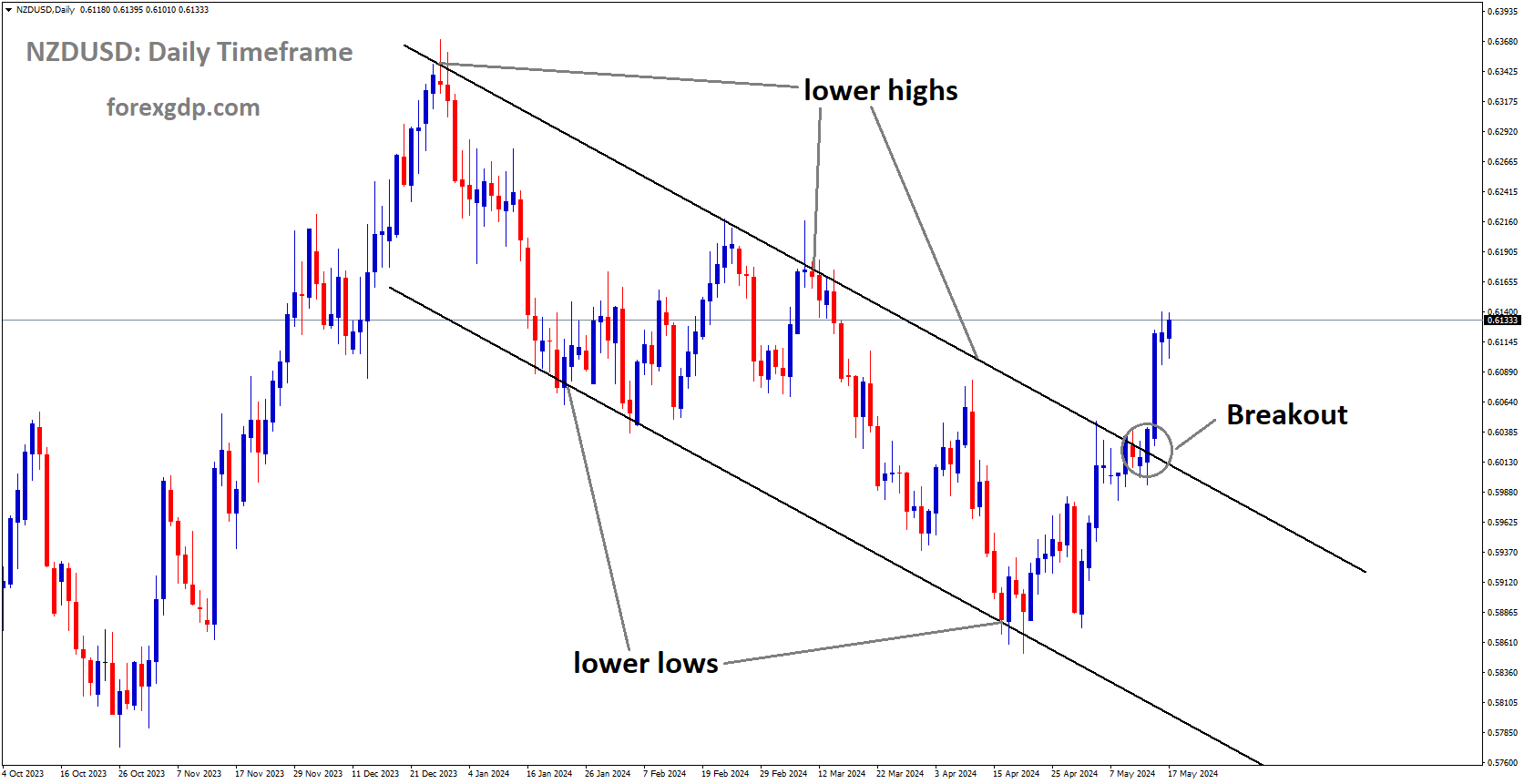
NZDUSD has broken Descending channel in upside
The Federal Reserve (Fed) remains vigilant about inflation and cautious regarding potential interest rate cuts in 2024. On Thursday, Raphael Bostic, President of the Federal Reserve Bank of Atlanta, emphasized the necessity of patience with interest rates, citing ongoing substantial pricing pressures within the US economy. Additionally, Loretta Mester, President of the Cleveland Fed, noted that it may take longer than expected to confidently determine the inflation trajectory, advocating for a prolonged restrictive monetary stance.
The US labor market data released on Thursday showed an increase in initial jobless claims to 222,000 for the week ending May 10, slightly above the market consensus of 220,000 but below the previous week’s figure of 232,000. This data suggests persistent challenges in the labor market, adding to the complex economic landscape the Fed must navigate.
In New Zealand, the Producer Price Index (PPI) inputs and outputs for the first quarter showed higher-than-expected increases, which could provide some support to the New Zealand Dollar (NZD). PPI input prices rose by 0.7%, aligning with market expectations, while PPI output prices increased by 0.9%, surpassing the anticipated 0.5%. According to Stats NZ, significant contributors to the rise in output prices included electricity and gas, which saw an 8.8% quarter-on-quarter increase, and energy costs, which boosted input prices by 11.6%. Additionally, insurance costs significantly impacted PPI input costs, rising by 5.0% quarter-on-quarter.

These robust PPI figures indicate underlying inflationary pressures in New Zealand, which may provide some support for the NZD, potentially limiting the downside of the NZD/USD pair. The higher-than-expected PPI data could also influence the Reserve Bank of New Zealand’s (RBNZ) future policy decisions, as it reflects cost pressures in the economy.
In summary, the NZD/USD pair’s decline is influenced by the strengthening US Dollar amid Fed caution and labor market challenges in the US. However, New Zealand’s strong PPI data may offer some support to the Kiwi, balancing the currency pair’s dynamics in the near term.
CRUDE OIL – Crude Oil Nears $80 as US Inflation Eases and Reserves Decline
West Texas Intermediate (WTI) crude oil is edging closer to the $80 per barrel mark as energy markets gain strength. This upward movement is driven by a combination of increasing risk appetite and optimistic expectations for potential rate cuts. Recent easing of US inflation data, along with a decline in US crude oil reserves, has sparked a surge in demand for barrels.
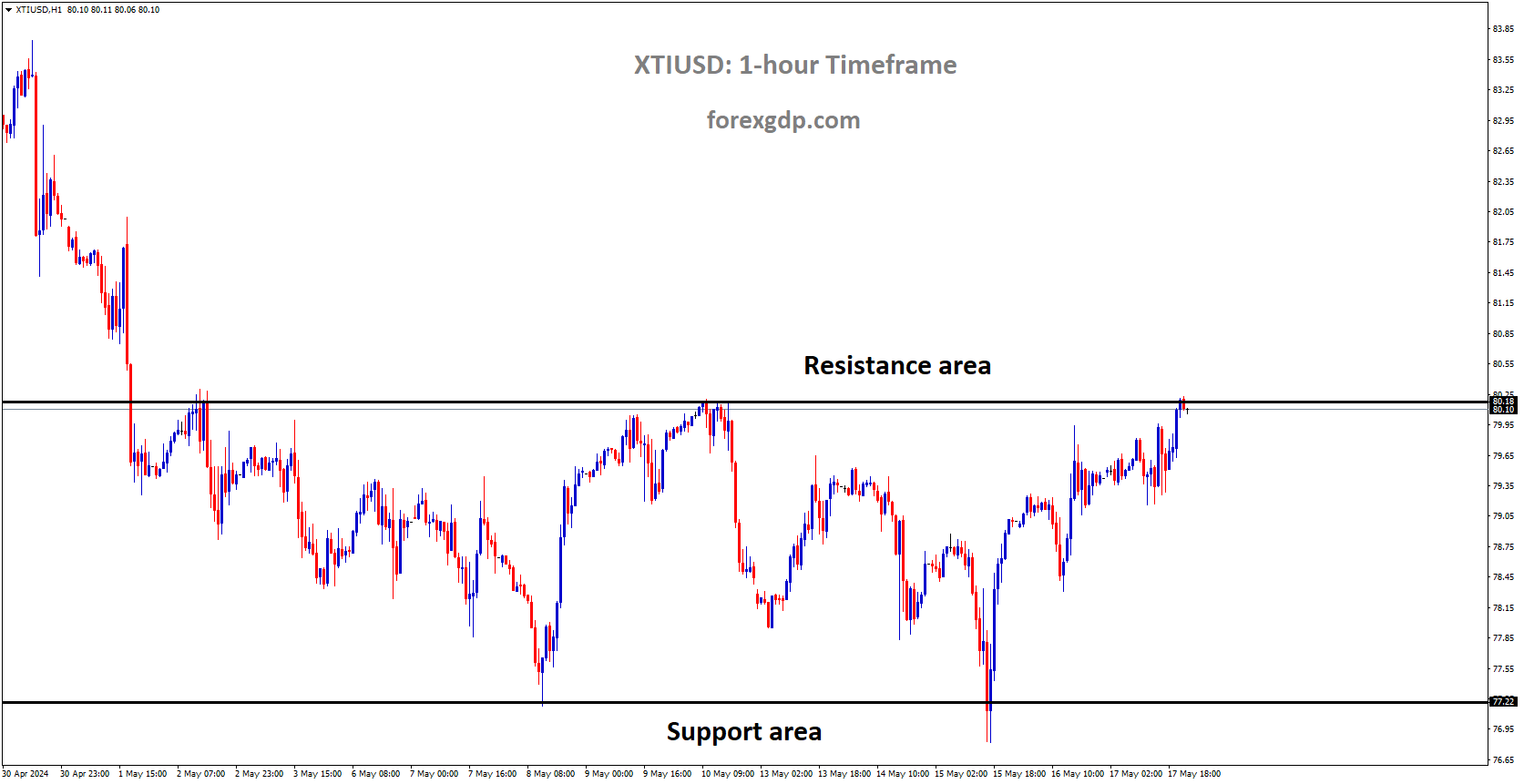
XTIUSD is moving in box pattern and market has reached resistance area of the pattern
On Friday, WTI experienced a significant rise in late-day trading, reflecting a broader recovery in crude oil markets. However, prices remained within the consolidation range observed in recent weeks. The support for US crude oil prices came from a notable decrease in barrel counts reported by both the Energy Information Administration (EIA) and the American Petroleum Institute (API) earlier in the week. This reduction in reserves, coupled with a broader market sentiment turning bullish, has contributed to the upward pressure on crude oil prices.
The latter half of the trading week saw a marked increase in risk appetite among investors. This shift was largely influenced by the latest US Consumer Price Index (CPI) data for April, which showed a more significant decrease in inflation than anticipated. The easing inflation figures have heightened expectations that the Federal Reserve (Fed) might implement rate cuts sooner than previously thought. This optimism has played a crucial role in lifting crude oil bids from their lowest levels since late February.
Despite the renewed speculation about potential rate cuts, Fed officials have adopted a cautious tone. Several Fed representatives have emphasized the need for patience and warned that interest rates could remain elevated for a longer period than markets currently expect. This cautious approach has been a key theme in recent Fed communications, reflecting a measured response to the evolving economic data.
As the trading week came to a close, the financial news cycle was heavily focused on Fed policy discussions. Investors are now preparing for the upcoming week, which will feature a series of appearances by Fed officials on Monday and Tuesday. These events are expected to provide further clarity on the Fed’s policy direction and potential adjustments to interest rates. The insights gleaned from these discussions will be crucial for shaping market expectations and guiding future investment decisions.
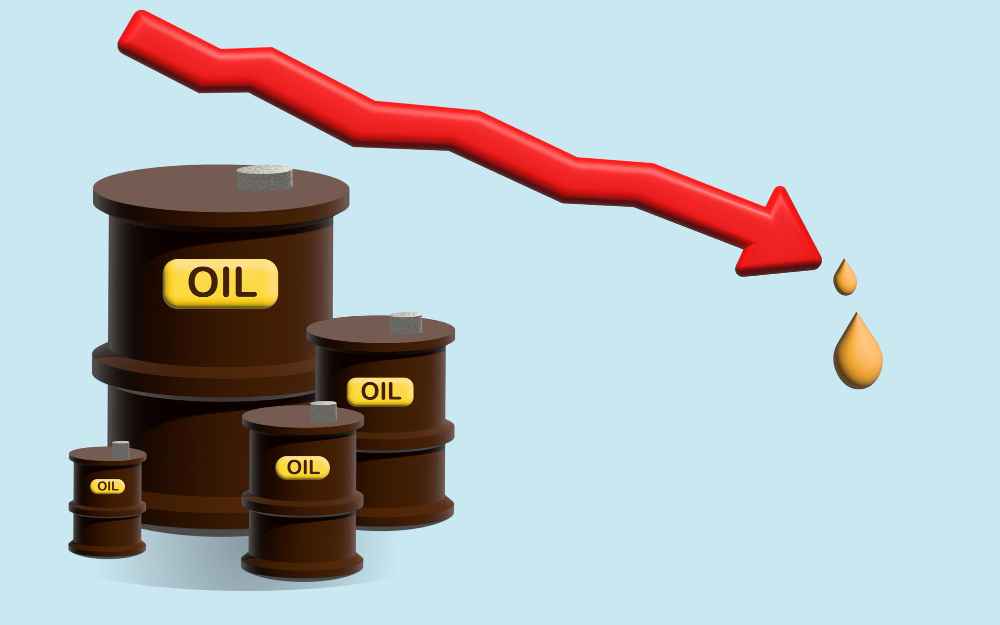
In summary, WTI crude oil is testing towards $80 per barrel, driven by a combination of easing US inflation, declining crude oil reserves, and increased risk appetite. While the market is optimistic about potential rate cuts, the Fed’s cautious stance suggests a need for patience and careful monitoring of economic indicators in the weeks ahead.
Don’t trade all the time, trade forex only at the confirmed trade setups
Get more confirmed trade signals at premium or supreme – Click here to get more signals , 2200%, 800% growth in Real Live USD trading account of our users – click here to see , or If you want to get FREE Trial signals, You can Join FREE Signals Now!



